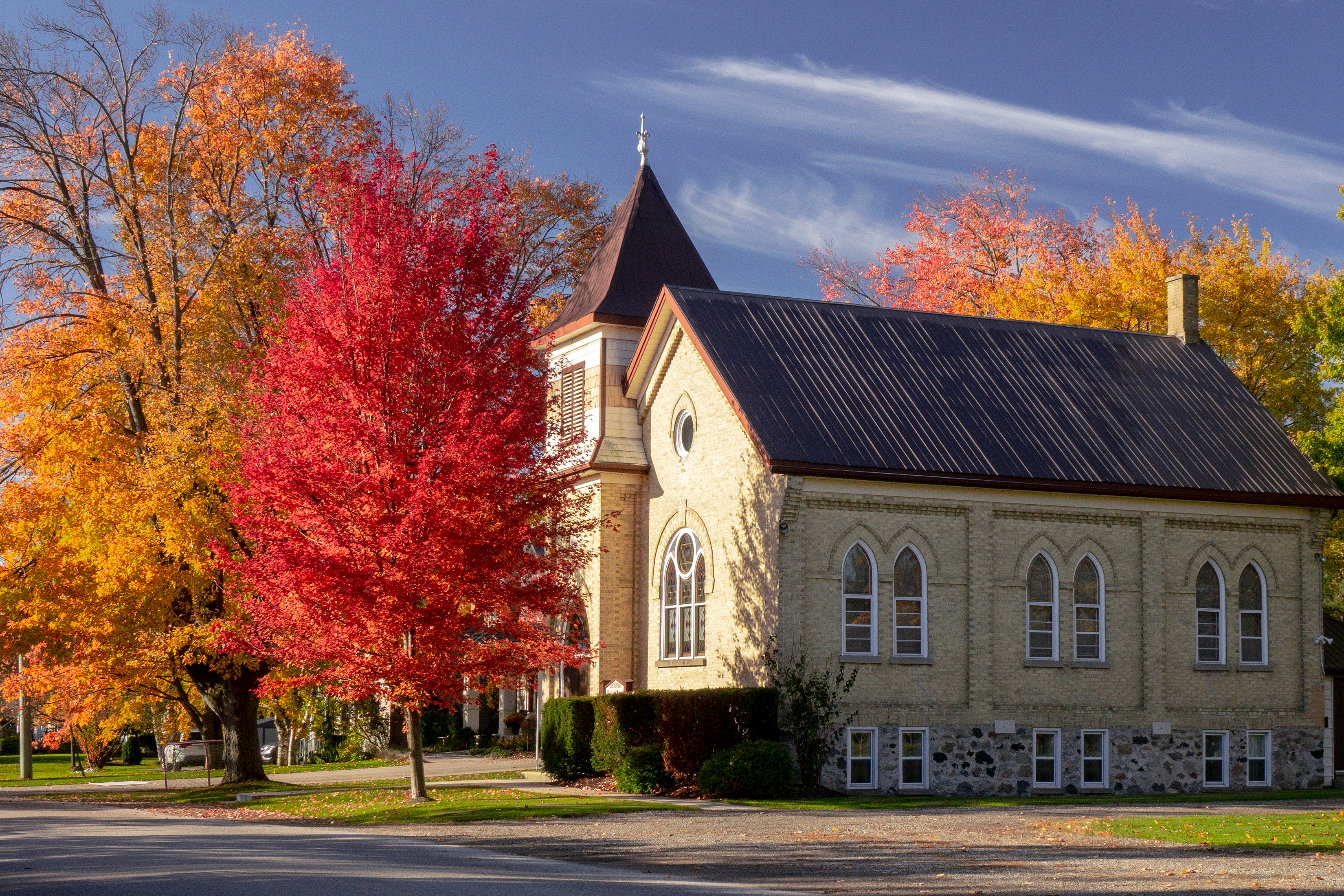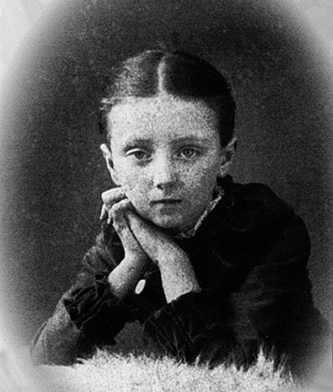|
St. Paul's Presbyterian Church (Leaskdale)
St. Paul's Presbyterian Church is a Presbyterian Church in Canada congregation located in the community of Leaskdale, Ontario, part of Uxbridge Township, Ontario Canada. It was started in March 1862 with thirteen Charter members, as the Scott Township mission of the Canada Presbyterian Church. The first building was opened in November 1864, on land given by George Leask. It was linked that year to Chalmer's Presbyterian Church now St. Andrew's-Chalmers Presbyterian Church in Uxbridge. After the Presbyterian Church in Canada was formed in 1875, the congregation was disjoined from Chalmer's in 1880. A preaching station was established in nearby Zephyr, Ontario, and they remained joined, until the Zephyr congregation disbanded and joined with St. Paul's in 1968. In 1906, following a period of growth, the congregation built the previous structure, and paid off the building debts by 1908. From 1910–1926, when both these congregations voted against (11–63 at St. Paul's) joini ... [...More Info...] [...Related Items...] OR: [Wikipedia] [Google] [Baidu] |
Presbyterian Church In Canada
The Presbyterian Church in Canada (french: Église presbytérienne du Canada) is a Presbyterian denomination, serving in Canada under this name since 1875. The United Church of Canada claimed the right to the name from 1925 to 1939. According to the Canada 2001 Census 409,830 Canadians identify themselves as Presbyterian, that is, 1.4 percent of the population. The Canadian roots of the Presbyterian Church in Canada can be traced to both Scottish settlers and French Huguenots, and the first Presbyterian churches formed in the late 16th and early 17th centuries, following such European Protestant Reformation theologians as John Calvin and John Knox. Once the largest Christian denomination in English-speaking Canada, in 1925 some 70 percent of its congregations joined with the Methodist Church, Canada and the Congregational Union of Ontario and Quebec to form the ''United Church of Canada''. The terms ''Continuing Presbyterians'' and ''Non-Concurring Presbyterians'' were then used ... [...More Info...] [...Related Items...] OR: [Wikipedia] [Google] [Baidu] |
Ecclesiastical Province Of Canada
The Ecclesiastical Province of Canada, founded in 1860, forms one of four ecclesiastical provinces in the Anglican Church of Canada. Despite modern use of the name ''Canada'', the ecclesiastical province covers only the former territory of Lower Canada (i.e., southern and eastern Quebec), the Maritimes, and Newfoundland and Labrador (The Ecclesiastical Province of Ontario split off as a separate entity in 1913.) The province comprises seven dioceses: * ''Montreal'' (within the secular Canadian province of Quebec) * ''Quebec'' (whose borders are consistent with Lower Canada outside Montreal) * ''Fredericton'' (New Brunswick) * ''Nova Scotia and Prince Edward Island'' (Nova Scotia and Prince Edward Island) * ''Western Newfoundland'' (Newfoundland and Labrador) * ''Central Newfoundland'' (Newfoundland and Labrador) * ''Eastern Newfoundland and Labrador'' (Newfoundland and Labrador) A Metropolitan, elected from among the province's diocesan bishops, heads each province o ... [...More Info...] [...Related Items...] OR: [Wikipedia] [Google] [Baidu] |
Uxbridge, Ontario
Uxbridge is a township in the Regional Municipality of Durham in south-central Ontario, Canada. Communities The main centre in the township is the namesake community of Uxbridge. Other settlements within the township include Altona, Coppin's Corners, Forsythe Glenn, Glasgow, Glen Major, Goodwood, Leaskdale, Quaker Village, Roseville, Sandford, Siloam, Udora, and Zephyr. History It was named for Uxbridge, England, a name which was derived from "Wixan's Bridge". The first settlers in the area were Quakers who started arriving in 1806 from the Catawissa, Pennsylvania, Catawissa area of Pennsylvania. The community's oldest building, the Uxbridge Friends Meeting House, was built in 1820 and overlooks the town from Quaker Hill, a kilometre to the west. The township was incorporated as a municipality in 1850 and became part of the newly formed Ontario County, Ontario, Ontario County two years later. The first passenger-carrying narrow-gauge railway in North America, the Toronto ... [...More Info...] [...Related Items...] OR: [Wikipedia] [Google] [Baidu] |
Uxbridge (town), Ontario
Uxbridge is a township in the Regional Municipality of Durham in south-central Ontario, Canada. Communities The main centre in the township is the namesake community of Uxbridge. Other settlements within the township include Altona, Coppin's Corners, Forsythe Glenn, Glasgow, Glen Major, Goodwood, Leaskdale, Quaker Village, Roseville, Sandford, Siloam, Udora, and Zephyr. History It was named for Uxbridge, England, a name which was derived from "Wixan's Bridge". The first settlers in the area were Quakers who started arriving in 1806 from the Catawissa area of Pennsylvania. The community's oldest building, the Uxbridge Friends Meeting House, was built in 1820 and overlooks the town from Quaker Hill, a kilometre to the west. The township was incorporated as a municipality in 1850 and became part of the newly formed Ontario County two years later. The first passenger-carrying narrow-gauge railway in North America, the Toronto and Nipissing Railway arrived in Uxbridge in Jun ... [...More Info...] [...Related Items...] OR: [Wikipedia] [Google] [Baidu] |
Congregationalists
Congregational churches (also Congregationalist churches or Congregationalism) are Protestant churches in the Calvinist tradition practising congregationalist church governance, in which each congregation independently and autonomously runs its own affairs. Congregationalism, as defined by the Pew Research Center, is estimated to represent 0.5 percent of the worldwide Protestant population; though their organizational customs and other ideas influenced significant parts of Protestantism, as well as other Christian congregations. The report defines it very narrowly, encompassing mainly denominations in the United States and the United Kingdom, which can trace their history back to nonconforming Protestants, Puritans, Separatists, Independents, English religious groups coming out of the English Civil War, and other English Dissenters not satisfied with the degree to which the Church of England had been reformed. Congregationalist tradition has a presence in the United States, ... [...More Info...] [...Related Items...] OR: [Wikipedia] [Google] [Baidu] |
United Church Of Canada
The United Church of Canada (french: link=no, Église unie du Canada) is a mainline Protestant denomination that is the largest Protestant Christian denomination in Canada and the second largest Canadian Christian denomination after the Catholic Church in Canada. The United Church was founded in 1925 as a merger of four Protestant denominations with a total combined membership of about 600,000 members: the Methodist Church, Canada, the Congregational Union of Ontario and Quebec, two-thirds of the congregations of the Presbyterian Church in Canada, and the Association of Local Union Churches, a movement predominantly of the Canadian Prairie provinces. The Canadian Conference of the Evangelical United Brethren Church joined the United Church of Canada on January 1, 1968. Membership peaked in 1964 at 1.1 million and has declined since that time. From 1991 to 2001, the number of people claiming an affiliation with the United Church decreased by 8%, the third largest decrease in ... [...More Info...] [...Related Items...] OR: [Wikipedia] [Google] [Baidu] |
Lucy Maud Montgomery
Lucy Maud Montgomery (November 30, 1874 – April 24, 1942), published as L. M. Montgomery, was a Canadian author best known for a collection of novels, essays, short stories, and poetry beginning in 1908 with '' Anne of Green Gables''. She published 20 novels as well as 530 short stories, 500 poems, and 30 essays. ''Anne of Green Gables'' was an immediate success; the title character, orphan Anne Shirley, made Montgomery famous in her lifetime and gave her an international following. Most of the novels were set in Prince Edward Island, and those locations within Canada's smallest province became a literary landmark and popular tourist site – namely Green Gables farm, the genesis of Prince Edward Island National Park. She was made an officer of the Order of the British Empire in 1935. Montgomery's work, diaries, and letters have been read and studied by scholars and readers worldwide. The L. M. Montgomery Institute, University of Prince Edward Island, is responsible for t ... [...More Info...] [...Related Items...] OR: [Wikipedia] [Google] [Baidu] |
Leaskdale Manse
The Leaskdale Manse, located in Uxbridge, Ontario, was the home of Lucy Maud Montgomery, author of the ''Anne of Green Gables'' series, and her husband Reverend Ewan Macdonald from 1911 to 1926. Montgomery wrote 11 of the 22 works published in her lifetime in the manse, as well as a series of journals that were published posthumously. The manse, constructed in 1886, was designated a National Historic Site of Canada in 1994 and is now a historic house museum. History The manse was constructed in 1886, by carpenter William Gordon and bricklayer Valentine Brooks, to serve as a residence for the pastor of St. Paul's Presbyterian Church. In 1911, Montgomery and Macdonald, newly married, moved to the town of Leaskdale, Ontario (now part of Uxbridge). As Macdonald was the pastor of St. Paul's Church, they took up residence in the manse. In her journals, Montgomery wrote that she enjoyed the rural environment of Leaskdale, but complained of the house's "ugly" design and its lack of a b ... [...More Info...] [...Related Items...] OR: [Wikipedia] [Google] [Baidu] |
Greater Toronto Area
The Greater Toronto Area, commonly referred to as the GTA, includes the City of Toronto and the regional municipalities of Durham, Halton, Peel, and York. In total, the region contains 25 urban, suburban, and rural municipalities. The Greater Toronto Area begins in Burlington in Halton Region, and extends along Lake Ontario past downtown Toronto eastward to Clarington in Durham Region. According to the 2021 census, the Census Metropolitan Area (CMA) of Toronto has a total population of 6,202,225. However, the Greater Toronto Area, which is an economic area defined by the Government of Ontario, includes communities which are not included in the CMA as defined by Statistics Canada. Extrapolating the data for all 25 communities in the Greater Toronto Area from the 2021 Census, the total population for the economic region included 6,712,341 people. The Greater Toronto Area is a part of several larger areas in Southern Ontario. The area is also combined with the city of Hamilton to ... [...More Info...] [...Related Items...] OR: [Wikipedia] [Google] [Baidu] |





